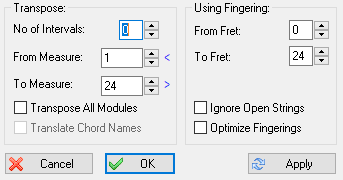Transpose
TablEdit's "Transpose…" feature not only allows you to transpose chords but also to transpose individual notes or an entire song if desired. You can easily modulate into a different key or shift to what ever fret position you want to play out of.

For example, if you had a riff in the first position in measures 3-6 that you'd like to move up the neck to the 5th position, you would enter a 3 in the "From Measure" field and a 6 in the "To Measure" field. Enter a "0" in the "No of Intervals" field since you don't want to modulate. Then enter a 5 in the "From Fret" field and a 10 in the "To Fret" field. Your riff will now be fingered in the 5th position, between frets 5 and 10.
TablEdit is even more powerful. If you want the same riff moved up neck to the 5th position but want to play the open strings as they are, see "Ignore Open Strings" below.
Steps for Transposing
| 1. | Select {Score | Transpose}. This will display the "Transpose" dialog. |
| 2. | Enter the number of intervals(semitones) upwards or downwards that you want the transposition to cover. A positive number will modulate up the number of intervals entered, while a negative number will modulate down the number of intervals entered. A value of zero modulates neither up nor down but can be useful when moving from one playing position to another. See sections 5 and 6. |
| 3. | Enter the number of first measure you want transposed in the "From Measure" field. |
| 4. | Enter the number of the last measure you want transposed into the "To Measure" field. |
| 5. | Enter the number of the lowest fret at which you want the selected measures to be fingered into the "From Fret" field. |
| 6. | Enter the number of the highest fret at which you want the selected measures to be fingered into the "To Fret" field. |
Note: You could also use the "To Fret" and "From Fret" fields to find a chord in the position you're playing. For example, suppose you were playing up the neck at the 5th position and thought a E maj add 9 would add to your riff. You could use the Chord Editor to build an E maj add 9 chord anywhere and then use Transpose to build the chord at the 5th position by entering a "0" in the "Intervals" field and a "5" in the "To Fret" field. Tabledit's transposer would then build the chord starting at the 5th position using only use frets up to the number you entered into the "From Fret" field.
Note that after transposing the notes, TablEdit recalculates the key of the transposed portion.
Ignore Open Strings
Selecting "Ignore Open Strings" will move only the fretted notes to the new position. For example, if you had the following riff (see A) in the first measure and you wanted to play it up the neck in the 5th position, you would enter "1" in the "From Measure" field and "1" in the "To Measure" field. Enter a "0" in "No of Intervals" since you don't want any modulation. Then enter a 5 in the "From Fret" field and a 10 in "To Fret". You now have 2 choices. You can leave the "Ignore Open Strings" box unchecked (see result B) or you can check it (see result C)
A B C (with Ignore Open Strings)
------------ ------------ ------------
-1-0---0-1-- ------------ ---0---0----
-----2------ -5-------5-- -5-------5--
------------ ---9-7-9---- -----7------
------------ ------------ ------------
------------ ------------ ------------
Optimize Fingerings
This option allows a tablature to be automatically reorganized, measure by measure, in order to render it playable by a human performer. In this case, the "From Fret:" and "To Fret:" settings are ignored.
Setting the "No of Intervals:" value to "0" allows the function, if at all possible, to rearrange the notes within the limits set by the minimum and maximum fret settings made. No notes are deleted during this procedure.
The use of this function is recommended after importing MIDI files.
Other options
The check box labeled "Transpose All Modules", as the label implies, allows the transposition to be applied to all of the modules of a tablature at the same time.
The "Translate Chord Names" option translates the custom chords. For example, with 2 as "No of Intervals:", the "C" becomes "D" etc...
The "Transpose" function is unavailable for drum tablatures where it would be meaningless. The dialog box is also simplified for an accordion where the notion of fret does not exist.